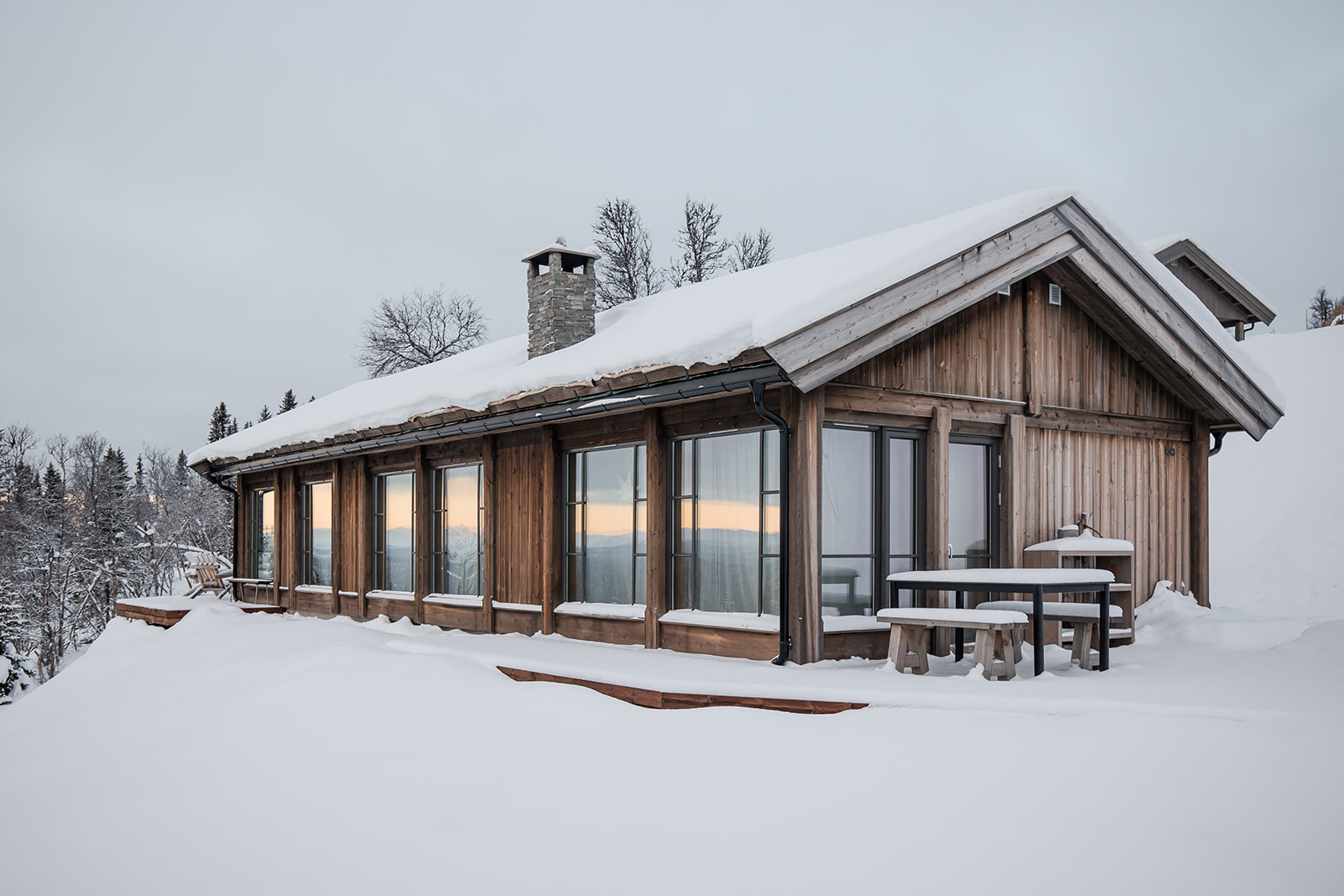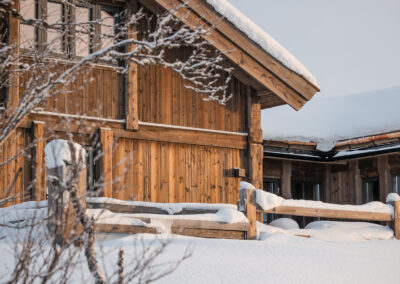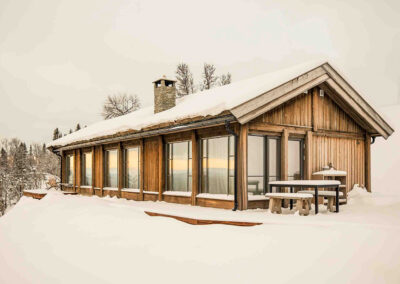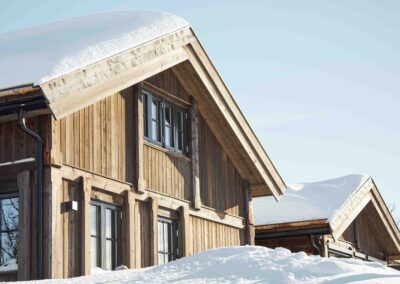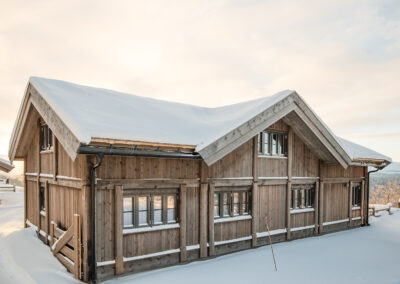Post and log construction cabin
A cabin in post and log construction from Skåbu Tradisjonsbygg AS gives you a unique combination of traditional Norwegian building techniques and modern building technology. This method of construction, which combines log, pole construction and timber framing, gives the cabins a very solid, aesthetically pleasing and robust expression.
Together with gate buildings, stave construction is the oldest Norwegian construction technique in wood and stretches so far back in time that it is not possible to date it exactly. The first timber frame buildings erected in Norway were most likely inspired by Southern European stone column structures. Post-and-beam construction originally consisted of wide panel boards, called staves, between strong sleepers and posts. In Norway, this construction method has been practiced since the Viking Age. The Norwegian stave churches are the oldest preserved examples of advanced stave constructions.
Our post and log construction cabins are a direct development of this traditional building method. A post and log cabin from Skåbu Tradisjonsbygg AS is very stylish and has a more modern look than ordinary log cabins. Like the stave churches, a stave cabin from us is characterized by coarse longitudinal sleepers, sturdy posts and solid roof locks in round logs. Between the posts and the sleepers, there are vertical panels (poles) as cladding on well-insulated exterior walls. One of our log cabins is characterized by the same structure as the log cabin; roof purlins, posts and sleepers in coarse Norwegian timber, and also has hand-hewn gables in coarse Norwegian pine timber.
With a pole or pole-vaulted cabin, you are freer to choose the floor plan than in a prefabricated cabin. A pole or pole-vaulted cabin is durable, sustainable and robust, giving you a warm, traditional cabin atmosphere and a healthy indoor climate.
In the late 1990s, Skåbu Tradisjonsbygg AS developed a completely new construction method for our post and log cabins. This method modernized the post and log cabin as a construction method, and re-emphasized the post and log cabin as an alternative for anyone who dreamed of a mountain cabin, but could not find an architecture and building style that suited. A modern post and log cabin from us has many elements from proud Norwegian building traditions, while at the same time satisfying all of today’s requirements and wishes for comfort and sustainability. The construction method, choice of materials and colors are adapted to nature, which is why such a post and log cabin blends extremely well into the mountain nature regardless of the season. We have more than 20 years’ experience of post and log construction, and we only use timber from the best areas in Norway.
We are happy to help you find the best solution for you!
Advantages of a post and log cabin
Aesthetics and charm: A post and log cabin from Skåbu Tradisjonsbygg AS has a traditional and rustic look that fits naturally into the mountains, and which many find charming. The sturdy corner posts and hand-hewn gables give the cabins an authentic feel. We treat the exterior of the cabins with iron vitriol as standard. Iron vitriol is well suited for use in dry mountain climates as it is a treatment that does not seal the wood, but allows any moisture to escape and lets the wood dry out. This prevents moisture and rot damage. Iron vitriol also accelerates the ageing process in the outermost layer of the wood so that the cabin is quickly affected by weather and wind and acquires a beautiful patina.
Flexibility: By combining hand lay-up, pole construction and timber framing, you get greater freedom in terms of room layout and furnishings. This makes it easier to adapt the cabin to your own wishes and needs.
Durability: Hand-hewn timber in the gables gives a warm, solid and traditional look, while all the rough materials make the cabins robust and durable. With simple maintenance, a post and log cabin will last significantly longer than an average cabin. Timber is a natural material that has been used in construction for centuries and is known for its strength and durability. This makes post and log cabins a long-term and reliable choice.
Environmental friendliness: A post and log cabin from Skåbu Tradisjonsbygg contributes to a significantly lower carbon footprint than most other types of cabin. In our standard post and log cabin, we use far more wood materials than is usual with the major cabin manufacturers. In addition to loft timber, roof trusses, posts and sleepers in coarse Norwegian timber, we use wooden materials in the floor, structure, wall panels, ceilings and roof trusses. Unlike many other cabin manufacturers, we don’t use MDF, processed wood panels, plaster, plastic, fiberglass or other artificial products. As a result, we use a very high percentage of renewable materials, making us more sustainable than most alternatives. The use of natural materials such as timber contributes to a lower carbon footprint compared to many modern building materials. Timber is a renewable resource that can be harvested sustainably and it stores carbon throughout its lifetime. This makes a log cabin an environmentally friendly choice for those looking to reduce their ecological footprint. A post and log cabin is an excellent choice for those who want a cabin with charm, flexibility and durability. With a post and log cabin, you get the best of both worlds – traditional Norwegian building techniques and modern building technology. These cabins are not only beautiful to look at, but also practical and adapted to today’s requirements for energy efficiency and flexibility. Whether you want a cozy mountain cabin or a spacious family cabin, a post and log cabin from Skåbu Tradisjonsbygg can be adapted to your wishes and needs. At Skåbu Tradisjonsbygg, we have extensive experience of this construction technique and, not least, customizing cabins for each individual customer.
The construction method
A pole and log cabin from Skåbu Tradisjonsbygg is built with strong external bottom and top logs. Between the bottom and top logs there are rough corner posts and posts on either side of the windows and doors. Between the sleepers and posts, our post and log cabins are clad with log panels. We use 12” dimension on the bottom logs and 8” dimension on the top logs. The corner posts are 10×10” and the posts are otherwise 8” wide. The gables of our post and log cabins are hand-laid with coarse Norwegian milled pine timber, while the gables of log cabins are built in the same way as the rest of the walls. Regardless of whether you choose a pole or pole-vaulted cabin, you’ll get strong roof purlins in round logs, usually spruce, as spruce is more tensile than pine.
Why choose a post and log cabin?
Choosing a post and log cabin means investing in a building that combines tradition and modern comfort with unique and distinctive architecture/aesthetics. These cabins are not only beautiful to look at, but also practical and very well adapted to today’s requirements for energy efficiency and flexibility.
Aesthetics and charm
Post and log cabins have a unique and charming appearance that stands out from all other buildings. The sturdy sleepers, posts and lath gables give the cabins an authentic feel that many find appealing. This traditional Norwegian construction method makes a post and log cabin a good choice for those who want a cabin with soul and character.
Flexibility
One of the biggest advantages of a post and log cabin versus a log cabin is the flexibility it offers. By combining hand-laid, pole construction and timber framing, you get greater freedom in terms of room layout and furnishings. This makes it easier to customize and tailor the cabin to your specific wishes and needs.
Energy efficiency
Efficient building materials such as sheathing and insulation are used in the framework and exterior walls of a post and log cabin. A post and log cabin is therefore usually more energy efficient than a prefabricated cabin. This also means that the cabins retain heat better in the winter and stay cooler in the summer than a standard timber frame cabin. It also contributes to lower energy costs and a more comfortable indoor climate.
